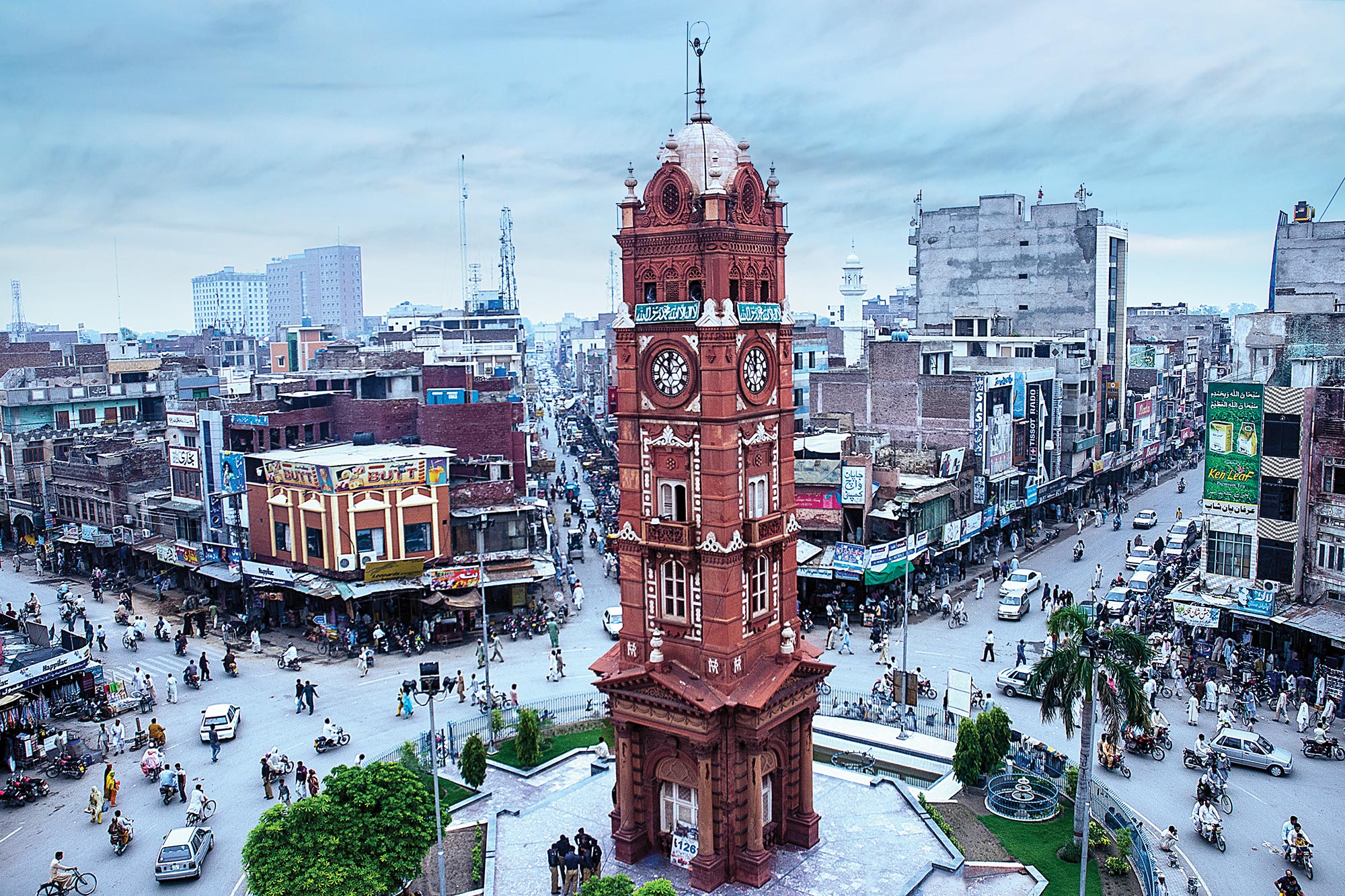
Faisalabad (Urdu: فیصل آباد; English: /fɑːɪsɑːlˌbɑːd/), formerly known as Lyallpur, is the third-most-populous city in Pakistan, and the second-largest in the eastern province of Punjab. Historically one of the first planned cities within British India, it has long since developed into a cosmopolitan metropolis. Faisalabad was restructured into city district status; a devolution promulgated by the 2001 local government ordinance (LGO). The total area of Faisalabad District is 5,856 km2 (2,261 sq mi) while the area controlled by the Faisalabad Development Authority (FDA) is 1,280 km2 (490 sq mi). Faisalabad has grown to become a major industrial and distribution center because of its central location in the region and connecting roads, rails, and air transportation. It has been referred to as the “Manchester of Pakistan”. As of 2013, GDP (PPP) of Faisalabad was estimated as $43 billion and projected to rise to $87 billion in 2025 at a growth rate of 5.7%. Faisalabad contributes over 20 percent to Punjab’s GDP and has an average annual GDP (nominal) of $20.5 billion. Agriculture and industry remain its hallmark.
Toponymy
Faisalabad district actually began as Lyallpur district in 1904 and prior to that, it was a tehsil of Jhang district. During the British Raj in colonial India, the city of Lyallpur was named in honor of the then Lieutenant-Governor of Punjab, Sir James Broadwood Lyall, for his services in the colonization of the lower Chenab Valley. The surname Lyall was joined with the noun ‘pur, meaning ‘city’ in Sanskrit. In 1979, the Government of Pakistan changed the name of the city from Lyallpur to Faisalabad (‘City of Faisal’) in honor of King Faisal of Saudi Arabia, who made several financial contributions to Pakistan.
Location
Faisalabad lies in the rolling flat plains of northeast Punjab, at 186 meters (610 ft) above sea level. The city proper comprises approximately 1,230 square kilometers (470 sq mi) while the district encompasses more than 16,000 square kilometers (6,200 sq mi). The Chenab River flows about 30 kilometers (19 mi), and the Ravi River meanders 40 kilometers (25 mi) to the southeast. The lower Chenab canal provides water to 80% of cultivated lands making it the main source of irrigation. Faisalabad is bound on the north by Chiniot and Sheikhupura, on the east by Sheikhupura and Sahiwal, on the south by Sahiwal and Toba Tek Singh and on the west by Jhang.
Geology
The district of Faisalabad is part of the alluvial plains between the Himalayan foothills and the central core of the Indian subcontinent. The alluvial deposits are typically over a thousand feet thick. The interfluves are believed to have been formed during the Late Pleistocene and feature river terraces. These were later identified as old and young floodplains of the Ravi River on the Kamalia and Chenab Plains. The old floodplains consist of Holocene deposits from the Ravi and Chenab rivers.
Climate
The average annual rainfall is approximately 615 millimeters (24.2 in). It is at its peak in July and August during monsoon season though western disturbances during winter months also bring considerable rainfall associated with hail. Monsoon season which starts in July and ends in September brings heavy rain to the city causing flash flooding. If the monsoon currents interact with the western disturbance, then cloudbursts can also occur. July is the wettest month of the year during which flooding is reported a number of times. Monsoon ends in September and then the dry period begins. October and November are the driest months with very little rainfall. During winter the weather usually remains cloudy associated with frequent fog. Record-breaking rainfall of 264.2 millimeters (10.40 in) was recorded on 5 September 1961 by the Pakistan Meteorological Department. The temperature of the city has reached a summer maximum record temperature of 48.0 °C (118.4 °F), which was observed on 9 June 1947 and again on 26 May 2010. Extreme minimum temperature of −4.0 °C (24.8 °F) was recorded on 15 January 1978. The highest wind gust ever recorded in Faisalabad occurred during a severe dust-thunderstorm on 2 June 2000, when the maximum wind speed reached 151 kilometers per hour (94 mph).
Transportation
Faisalabad is well-connected by rail, road and air. Public transportation in Faisalabad includes auto-rickshaws, buses and railways. Faisalabad International Airport is located on the outskirts of the city, and operates flights to the Middle East.
Culture
Faisalabad, the third most populated metropolis in Pakistan after Karachi and Lahore is an epicenter for trade that has gained popularity for its colonial heritage sites. In 1982, the Government of Punjab established the Faisalabad Arts Council, a division of the Punjab Arts Council which is overseen administratively by the Information, Culture and Youth Affairs Department. The Faisalabad Arts Council building, designed by architect Nayyer Ali Dada, was completed in 2006. The auditorium was named after the late Nusrat Fateh Ali Khan, a Pakistani musician, and singer.
Sources: Wikipedia